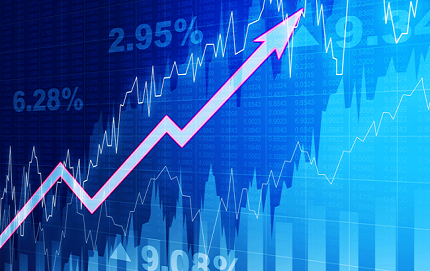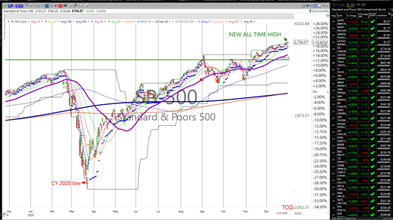We live in interesting times.
There is discussion about whether the saying, “May you live in interesting times,” is a blessing or a curse. At this point in 2020, we all understand why.
Last week, the world watched in consternation as the price of oil, specifically West Texas Intermediate crude oil, dropped into negative territory. The price moved below zero because a purchase date coincided with a lack of storage space. As a result, the owners of the oil had to pay to have it taken off their hands, reported Ben Levisohn of Barron’s.
Oil prices recovered on Wednesday. Global oil producers have promised to reduce output, which would realign supply and demand, but it has yet to happen, reported Evie Liu of Barron’s. The delay may reflect a hope that coronavirus restrictions will ease, economies will begin to reopen, and demand for oil will increase.
Investors were understandably unsettled by oil prices, and U.S. stocks lost value early in the week. As oil stabilized, U.S. stocks pushed higher. The rebound in stocks stalled on news that trials for a potential COVID-19 treatment had produced disappointing results.
Thursday’s unemployment data showed 4.4 million people filed for unemployment benefits the previous week. That brought the number of unemployed Americans to more than 26 million, according to Jeffry Bartash of MarketWatch.
Earnings, which reflect companies’ profits, remained less than robust, as expected. “The blended (combines actual results for companies that have reported and estimated results for companies that have yet to report) earnings decline for the first quarter is -15.8 percent…” reported John Butters of FactSet.
The energy sector finished the week in positive territory.
Stimulus checks are arriving
The Internal Revenue Service (IRS) has distributed $157.9 billion through 88 million stimulus payments, according to Andrew Keshner of MarketWatch.
If you have recently lost a job, or you’re having difficulty paying bills, your check may already be spent. However, if you’re still working, or remain financially comfortable, think carefully about how you want to spend your checks. The money could be used to improve your long-term financial outlook or provide support to people in need. For instance, you could:
- Contribute to an emergency fund. It’s a sound idea to have savings equal to three to six months of expenses in a rainy-day fund in case something unexpected happens, such as a coronavirus quarantine.
In 2019, the Board of Governors of the Federal Reserve reported just 61 percent of adults had enough savings set aside to cover a $400 unexpected expense. The report stated, “During 2018, one-fifth of adults had major, unexpected medical bills to pay, with the median expense between $1,000 and $4,999. Among those with medical expenses, 4 in 10 have unpaid debt from those bills.”
- Pay off high-interest rate debt. If your income is secure, using your check to reduce high interest rate debt may be a good choice.
In early April, the average interest rate assessed on credit cards accounts with unpaid balances was 16.61 percent. Reducing your balance, could significantly reduce the amount of interest you pay. In addition, if something unexpected happens, having a higher level of available credit could be beneficial.
Donate the amount. If you are confident you will not need the money, consider making a donation. A donation can take many forms. You could help a loved one pay bills or provide support to a church or charity.
“…many charities and nonprofits are still struggling. Donations to some churches have plummeted, and many charities have had to cancel crucial fundraising events such as galas, bike races, and walkathons,” reported the Associated Press.
What are you planning to do with your stimulus check?
Weekly Focus – Think About It
“Do you think you remember a movie in which a knight gallops toward a castle just as its drawbridge is going up, and his white horse jumps the moat in one glorious airborne leap?
…we’re that rider. Chasing us is the dreaded coronavirus. We’re in midair, hoping we make it to the other side, where life will have returned to what we think of as normal. So, what should we do while we’re up there, between now and then? Think of all the things you hope will still be there in that castle of the future when we get across. Then do what you can, now, to ensure the future existence of those things.”
-Margaret Atwood, Time Magazine, April 16, 2020
Best regards,
Jack Reutemann, Jr. CLU, CFP®
P.S. Please feel free to forward this commentary to family, friends, or colleagues.
Most Popular Financial Stories
Don’t forget about your 2020 IRA contributions!
There’s still time to contribute to your IRA!If you haven’t already contributed to an IRA (Individual Retirement Account), there’s still time to do so. Many...
Special Edition from Jack – the 45 DAY REPORT!
Special Edition from Jack – the 45 DAY REPORT! Friends and Clients, Hard to believe, isn’t it? The first quarter is half over. The year is 45 days old. It’s 1/8th over...
Valentine’s Day Message
How Are Your Investments Doing Lately? Receive A Free, No-Obligation 2nd Opinion On Your Investment Portfolio > December 9, 2020 Our Mission Is To Create And Preserve...
SPECIAL EDITION MARKET UPDATE
How Long Can This Last?Performance NumbersOur aggressive growth model is once again outpacing the S&P 500 Index. We’re up 8.48% year-to-date, while the...
When the Year Is New
Time to Take Stock Bye-bye 2020. For everything not financial, we don’t hate to see you go. Pandemics. Riots. Elections. Safe Distancing. Masks. Lockdowns. The parade of...
Special Edition – Year End Tax Matters
Making a List and Checking It TwiceAs one of the strangest years ever thankfully draws to a close, it behooves us to take stock and see our situation as it now...
Investment advice offered through Research Financial Strategies, a registered investment advisor.
* This newsletter and commentary expressed should not be construed as investment advice.
* Government bonds and Treasury Bills are guaranteed by the U.S. government as to the timely payment of principal and interest and, if held to maturity, offer a fixed rate of return and fixed principal value. However, the value of fund shares is not guaranteed and will fluctuate.
* Corporate bonds are considered higher risk than government bonds but normally offer a higher yield and are subject to market, interest rate and credit risk as well as additional risks based on the quality of issuer coupon rate, price, yield, maturity, and redemption features.
* The Standard & Poor’s 500 (S&P 500) is an unmanaged group of securities considered to be representative of the stock market in general. You cannot invest directly in this index.
* All indexes referenced are unmanaged. The volatility of indexes could be materially different from that of a client’s portfolio. Unmanaged index returns do not reflect fees, expenses, or sales charges. Index performance is not indicative of the performance of any investment. You cannot invest directly in an index.
* The Dow Jones Global ex-U.S. Index covers approximately 95% of the market capitalization of the 45 developed and emerging countries included in the Index.
* The 10-year Treasury Note represents debt owed by the United States Treasury to the public. Since the U.S. Government is seen as a risk-free borrower, investors use the 10-year Treasury Note as a benchmark for the long-term bond market.
* Gold represents the afternoon gold price as reported by the London Bullion Market Association. The gold price is set twice daily by the London Gold Fixing Company at 10:30 and 15:00 and is expressed in U.S. dollars per fine troy ounce.
* The Bloomberg Commodity Index is designed to be a highly liquid and diversified benchmark for the commodity futures market. The Index is composed of futures contracts on 19 physical commodities and was launched on July 14, 1998.
* The DJ Equity All REIT Total Return Index measures the total return performance of the equity subcategory of the Real Estate Investment Trust (REIT) industry as calculated by Dow Jones.
* The Dow Jones Industrial Average (DJIA), commonly known as “The Dow,” is an index representing 30 stock of companies maintained and reviewed by the editors of The Wall Street Journal.
* The NASDAQ Composite is an unmanaged index of securities traded on the NASDAQ system.
* International investing involves special risks such as currency fluctuation and political instability and may not be suitable for all investors. These risks are often heightened for investments in emerging markets.
* Yahoo! Finance is the source for any reference to the performance of an index between two specific periods.
* Opinions expressed are subject to change without notice and are not intended as investment advice or to predict future performance.
* Economic forecasts set forth may not develop as predicted and there can be no guarantee that strategies promoted will be successful.
* Past performance does not guarantee future results. Investing involves risk, including loss of principal.
* The foregoing information has been obtained from sources considered to be reliable, but we do not guarantee it is accurate or complete.
* There is no guarantee a diversified portfolio will enhance overall returns or outperform a non-diversified portfolio. Diversification does not protect against market risk.
* Asset allocation does not ensure a profit or protect against a loss.
* Consult your financial professional before making any investment decision.
* To unsubscribe from the Weekly Market Commentary please reply to this e-mail with “Unsubscribe” in the subject.
Investment advice offered through Research Financial Strategies, a registered investment advisor.
Sources:
https://en.wikipedia.org/wiki/May_you_live_in_interesting_times
https://www.barrons.com/articles/in-a-stock-market-like-this-anything-could-cause-the-next-panic-heres-what-to-watch-51587776542?mod=hp_HERO (or go to https://peakcontent.s3-us-west-2.amazonaws.com/+Peak+Commentary/04-27-20_Barrons-In_a_Stock_Market_Like_This_Anything_Could_Cause_the_Next_Panic-Heres_What_to_Watch-Footnote_2.pdf)
https://www.barrons.com/articles/dow-jones-industrial-average-rose-as-oil-prices-came-back-51587591022?refsec=markets (or go to https://peakcontent.s3-us-west-2.amazonaws.com/+Peak+Commentary/04-27-20_Barrons-The_Dow_Rose_457_Points_Because_Oil_Prices_Came_Back-Footnote_3.pdf)
https://www.marketwatch.com/story/jobless-claims-jump-another-44-million-25-million-americans-have-lost-their-jobs-to-the-coronavirus-2020-04-23
https://www.investopedia.com/terms/e/earnings.asp
https://insight.factset.com/sp-500-earnings-season-update-april-24-2020
https://www.marketwatch.com/story/the-irs-has-already-paid-out-over-half-the-stimulus-check-money-heres-where-it-went-2020-04-24
https://www.federalreserve.gov/publications/2019-economic-well-being-of-us-households-in-2018-dealing-with-unexpected-expenses.htm
https://www.federalreserve.gov/releases/g19/current/default.htm
https://apnews.com/0cca8af954b111ef460d823f7cd81a49
https://time.com/collection/finding-hope-coronavirus-pandemic/5820595/margaret-atwood-coronavirus-uncertainty/




